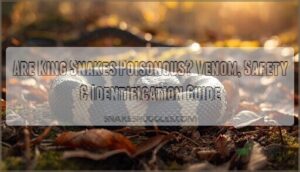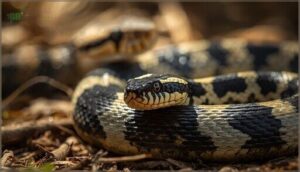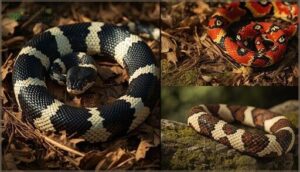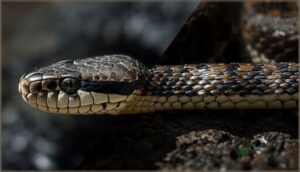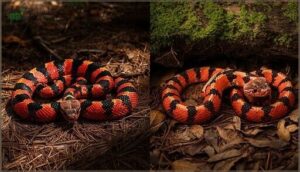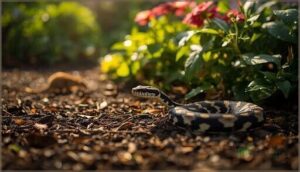This site is supported by our readers. We may earn a commission, at no cost to you, if you purchase through links.
You spot a snake with bold bands of black, white, and red slithering across your backyard, and panic sets in—it looks dangerous. Your neighbor insists king snakes are harmless, but those bright warning colors tell a different story, right?
Here’s the thing: king snakes aren’t poisonous, and they’re not venomous either. These constrictors pose zero toxic threat to humans, yet they’ve earned a fearsome reputation by mimicking the appearance of deadly coral snakes and regularly feasting on rattlesnakes and copperheads.
Understanding the difference between poisonous and venomous—and knowing what king snakes actually are—can transform your fear into appreciation for one of North America’s most beneficial reptiles.
Table Of Contents
- Key Takeaways
- Are King Snakes Poisonous?
- Do King Snakes Have Venom?
- Are King Snakes Dangerous to Humans?
- How to Identify a King Snake
- What Do King Snakes Eat?
- Are King Snakes Good to Have Around?
- Frequently Asked Questions (FAQs)
- What snake looks like a king snake but is poisonous?
- Do king snakes eat rattlesnakes?
- Are California King Snakes Venomous?
- Are kingsnakes dangerous to humans?
- What kind of snake is a king snake?
- Are king snakes venomous?
- Are king snakes good pets?
- Is a king snake harmful to humans?
- Is it good to have a king snake in your yard?
- Are kingsnakes aggressive?
- Conclusion
Key Takeaways
- King snakes are neither poisonous nor venomous—they’re harmless constrictors that lack venom glands and specialized fangs, relying entirely on constriction to subdue prey and posing zero toxic threat to humans.
- These snakes possess remarkable venom immunity that allows them to hunt and consume venomous species like rattlesnakes and copperheads without suffering harm, making them valuable natural pest controllers.
- Misidentification is common because scarlet king snakes mimic the appearance of deadly coral snakes through similar color banding, but you can distinguish them using the rhyme “red touches black, friend of Jack” (though you should always maintain a safe distance if uncertain).
- Having king snakes around your property provides substantial ecological benefits by controlling rodent populations and reducing encounters with venomous snakes, though their bites may cause minor punctures if you handle them roughly.
Are King Snakes Poisonous?
No, king snakes aren’t poisonous, and they aren’t venomous either. Understanding the difference between these terms clears up a lot of confusion about what these snakes can and can’t do to you.
Let’s break down what makes king snakes harmless, tackle the facts about their biology, and address some common myths you might’ve heard.
Poisonous Vs. Venomous Explained
Understanding the difference matters more than you’d think. Venomous animals deliver toxins through bites or stings, injecting venom directly into your bloodstream. Poisonous creatures release toxins when you touch or eat them.
Despite this clear distinction, surveys show 72% of adults mix up these terms—a misconception that’s shaped how we view animal toxins and their evolutionary significance in nature. Some creatures use toxins as defense mechanisms.
King Snake Toxicity Facts
King snakes carry no venom or toxin whatsoever. You won’t find venom glands or specialized fangs in any Lampropeltis species—they’re pure constrictors. If a king snake bites you, expect minor punctures and local swelling, nothing systemic. No antivenom exists because none is needed.
Ironically, these nonvenomous snakes possess toxin immunity that lets them prey on rattlesnakes and copperheads without harm. As carnivores, their diet includes rodents.
Myths and Misconceptions
Despite their harmlessness, kingsnakes face widespread public fear—about 86% of people express snake phobia, and 43% actively dislike these nonvenomous reptiles. Mimicry misidentification fuels confusion when scarlet kingsnakes resemble coral snakes, leading to unnecessary kills.
Rural misconceptions persist, including milk snake myths about barn-dwelling serpents “suckling” cows.
Media portrayal often conflates harmless constrictors with venomous species, reinforcing fear rather than educating viewers about their ecological value.
Do King Snakes Have Venom?
No, king snakes don’t have venom glands or fangs. Unlike venomous species, they rely entirely on constriction to subdue their prey, which means they pose no toxic threat to you or other animals.
Understanding how king snakes differ from venomous snakes can help you feel more confident when you encounter one in the wild.
Venom Glands and Fangs
You won’t find venom glands or specialized fangs in a king snake’s mouth—they’re built for mechanical predation instead. Unlike rear-fanged colubrids with Duvernoy’s glands, kingsnakes (genus Lampropeltis) lack the anatomical equipment to deliver toxins into prey or humans.
- Gland Absence: Kingsnakes either completely lack Duvernoy’s glands or possess only atrophied remnants with no functional venom secretion
- Fang Morphology: All their teeth are solid and uniformly shaped (aglyphous dentition), preventing high-pressure venom delivery
- Venom Delivery: Without grooved or hollow fangs, kingsnakes can’t inject toxins even if they wanted to
- Human Safety: Bites cause only mechanical injury—superficial punctures with no systemic toxic effects
Comparison to Venomous Snakes
When you compare kingsnakes to venomous species like coral snakes, the differences run deeper than color patterns. Venomous snakes deliver toxins through hollow or grooved fangs connected to venom glands, while this nonvenomous snake uses pure constriction for prey subjugation.
You’ll notice physical distinctions immediately—kingsnakes lack the specialized venom delivery system entirely, relying instead on mimicry defense and muscular power rather than chemical weapons.
Effects on Prey and Humans
When kingsnakes attack prey, their constriction pressure exceeds 180 mmHg—enough to cause rapid circulatory arrest in rodents and even venomous snakes. Their venom resistance neutralizes pit viper toxins completely, allowing safe predation on rattlesnakes.
King snakes kill prey with bone-crushing constriction and resist venom so completely they hunt rattlesnakes without harm
If you’re bitten, you’ll experience only brief localized pain and minor bleeding, nothing like a venomous snake bite. Behavioral risks increase when you handle them roughly, though kingsnakes remain generally nonaggressive.
Are King Snakes Dangerous to Humans?
King snakes don’t pose a real threat to people, but understanding their behavior helps you know what to expect if you encounter one. While they’re generally docile, there are situations where they might defend themselves, and knowing how they react can keep both you and the snake safe.
Let’s look at bite potential, their natural defense strategies, and practical safety measures you should take around these harmless constrictors.
Potential for Bites
You’re far more likely to get scratched by your cat than bitten by a king snake.
Kingsnake bites are extremely rare, accounting for less than 1% of medically attended snake bite cases annually. Bite circumstances generally involve deliberate handling or accidental encounters during capture attempts.
When bites do occur, bite severity remains minimal—expect minor pain and superficial bleeding that heals quickly without medical intervention.
King Snake Defense Mechanisms
When threatened, you’ll witness a king snake deploy a complex arsenal rather than simply fleeing. These kingsnake defense mechanisms protect them without posing serious kingsnake safety concerns for humans.
- Tail vibration mimics rattlesnakes, generating acoustic deterrents above 10 Hz in dry leaves—a textbook example of Batesian mimicry alongside their tri-colored patterns
- Musk release spreads foul-smelling cloacal secretions that persist for hours, forcing predators to abandon attacks within seconds
- Camouflage behavior blends patterned scales with leaf litter, making detection difficult before escape attempts begin
Venom resistance adds another layer of protection during confrontations with pit vipers.
Safety Precautions Around King Snakes
Handling a king snake safely starts with simple awareness: you’ll avoid most kingsnake bites by not grabbing wild individuals and supporting captive snakes hand-over-hand during brief 10–15 minute sessions. Skip handling 48 hours post-feeding or during cloudy-eyed shed periods when defensive strikes spike. Wash hands before and after contact to prevent Salmonella transmission—important for child safety and immunocompromised household members.
| Handling Techniques | Bite Prevention | Hygiene Practices |
|---|---|---|
| Allow hand-over-hand movement | Wear boots and long pants outdoors | Wash hands with soap immediately after contact |
| Limit sessions to 10–15 minutes | Avoid handling during pre-shed opaque eye stage | Clean equipment outside kitchen areas |
| Use snake hooks for distance | Never grab wild snakes directly | Dispose waste via toilet, not sinks |
How to Identify a King Snake
If you spot a snake in your yard or on a hike, you’ll want to know whether it’s a harmless king snake or something more dangerous.
Fortunately, king snakes have distinctive features that make identification straightforward once you know what to look for. Let’s examine the key characteristics that set these constrictors apart from other species.
Color Patterns and Markings
Kingsnakes exhibit striking color patterns, including bold black-and-white bands, tri-colored rings of red, yellow bands, and black, or reddish-brown blotches on lighter backgrounds. Pattern mimicry makes scarlet kingsnakes resemble venomous coral snakes, following the rule: “red touches black, not yellow.”
Regional variations introduce gray, tan, or even melanistic forms. Juvenile markings often appear brighter, with ontogenetic changes dulling colors as snakes mature. Color genetics determine whether banding appears ringed or striped.
Head Shape and Body Features
Beyond color patterns, you’ll notice kingsnake identification relies on physical characteristics like head-neck differentiation. Their heads appear only slightly wider than the neck, creating a spoon-shaped profile rather than the triangular outline typical of pit vipers.
Body proportions reveal smooth scale patterns and cylindrical body girth, with an undivided anal plate distinguishing them from many other snakes. These kingsnake characteristics help confirm non-venomous snake appearance.
Differentiating King Snakes From Venomous Species
That spoon-shaped head you’ve confirmed still won’t guarantee you’re safe—coral snake identification errors drive 18% of southeastern snakebite visits. Scarlet kingsnakes mimic coral snakes so precisely that juvenile markings confuse even experienced handlers.
Regional variations compound this: while “red touches black, friend of Jack” works in most areas, don’t rely solely on snake mimicry patterns.
When uncertain about venomous vs poisonous snakes, back away and call professionals.
What Do King Snakes Eat?
King snakes have a reputation as fearless hunters with a surprisingly diverse menu. Their diet includes everything from small rodents and birds to other reptiles, and they’re especially known for eating venomous snakes without suffering any harm.
Understanding what these constrictors eat reveals why they’re such valuable members of the ecosystems they inhabit.
Typical Diet in The Wild
Kingsnakes are generalist predators, meaning they’ll eat whatever crosses their path. Their diet reflects where they hunt—and you’ll find they’re not picky eaters.
Here’s what you can expect to see on a kingsnake’s menu:
- Other snakes (including rattlesnakes and copperheads), making up roughly 29% of recorded prey items
- Small mammals like mice and rodents, contributing about 29% of their diet
- Lizards and reptile eggs, particularly common in southeastern populations
- Birds and amphibians, rounding out their opportunistic feeding habits
This ophiophagy—snake-eating behavior—makes them valuable allies in controlling both rodent and venomous snake populations near your property.
Immunity to Venomous Snake Bites
What makes kingsnakes fearless rattlesnake predators? They possess venom resistance through specialized blood proteins that neutralize rattlesnake venom by up to 75%. However, resistance limits exist—kingsnakes remain vulnerable to coral snake venom, showing evolutionary implications tied specifically to their viperid prey.
Research gaps persist regarding molecular pathways and genetic mechanisms, but this immunity explains why you’ll find nonvenomous kingsnakes confidently hunting venomous species in your area.
Ecological Benefits of King Snakes
When kingsnakes control rodent pests, they’re reducing crop damage that costs millions annually—pest control without chemicals. Their ophiophagy, or snake-eating behavior, regulates venomous species like rattlesnakes, making your community safer.
However, this predation has a darker side: invasive kingsnakes caused a 98% decline in island lizard populations, showing how their ecological role depends entirely on habitat context.
Are King Snakes Good to Have Around?
If you’ve spotted a king snake on your property, you might wonder whether it’s a welcome guest or a cause for concern. The answer depends on what you value in your yard and how you feel about sharing space with a natural predator.
Let’s look at the benefits and considerations of having king snakes around.
Role in Controlling Pests
You’ll appreciate kingsnakes as natural pest controllers in your yard. These constrictors excel at rodent population control, consuming mice that damage crops and stored food.
Through ophiophagy—eating other snakes—they suppress venomous rattlesnakes, reducing risks to you and livestock.
Their ecological role extends to agricultural pest management, where they minimize your need for chemical rodenticides while targeting invasive species that threaten native wildlife.
Impact on Ecosystem Balance
When kingsnakes move into new territories as invasive predators, they can drastically alter food web dynamics through prey reduction—some island populations show over 90% declines in native lizards. This habitat alteration triggers cascading effects on pollination and seed dispersal.
However, in their native range, genetic diversity and adaptability help kingsnakes maintain ecological role balance without devastating local ecosystems, unlike their invasive counterparts elsewhere.
Considerations for Keeping King Snakes as Pets
Thinking about kingsnakes as pets? You’ll need an escape-proof enclosure at least 4x2x2 feet, with temperatures between 75-90°F and proper humidity.
Feeding schedules vary by age—hatchlings eat weekly, adults every 10-14 days. Handle them gently 1-2 times weekly once acclimated.
Regular health monitoring prevents respiratory infections and mites. Check local legal compliance requirements before bringing a pet snake home, as regulations differ by region.
Frequently Asked Questions (FAQs)
What snake looks like a king snake but is poisonous?
The eastern coral snake is venomous and frequently confused with king snakes due to similar red, yellow, and black banding.
Remember the safety mnemonic: “Red touch yellow, kill a fellow; red touch black, friend of Jack.”
Do king snakes eat rattlesnakes?
Yes, rattlesnakes are sitting ducks for kingsnakes. These fearless constrictors regularly consume rattlesnakes whole—head-first—comprising about 24% of their diet by frequency, thanks to natural venom resistance and powerful constriction mechanisms that safely subdue venomous prey.
Are California King Snakes Venomous?
California kingsnakes are nonvenomous snakes, lacking venom glands entirely. Their saliva contains no medically significant toxins, and bites cause only minor puncture wounds.
You won’t experience systemic effects or serious injury from these harmless constrictors.
Are kingsnakes dangerous to humans?
Despite their intimidating reputation, kingsnakes pose virtually no danger to humans under normal circumstances. Kingsnake bites cause only minor discomfort, and proper snake safety practices—gentle handling and handwashing—effectively minimize the already negligible handling risks.
What kind of snake is a king snake?
King snakes belong to the Lampropeltis genus within the Colubrid family.
This genus contains approximately 14–26 recognized king snake species and over 45 subspecies, making scientific designation and identifying king snakes taxonomically complex yet fascinating.
Are king snakes venomous?
No, kingsnakes aren’t venomous. They lack venom glands and specialized fangs for venom delivery, relying instead on constriction to subdue prey.
Their bites cause minimal harm, producing no toxin composition or systemic effects.
Are king snakes good pets?
Yes, kingsnakes make excellent beginner-friendly pet snakes with docile temperaments and hardy care requirements. You’ll manage straightforward feeding schedules and moderate enclosure size needs, though you must address zoonotic risks through consistent hygiene practices.
Is a king snake harmful to humans?
You don’t need to worry—kingsnakes pose minimal handling risks to humans. While defensive bites can occur, they’re non-venomous and cause only minor irritation.
Child safety and pet safety remain high, with no systemic toxicity.
Is it good to have a king snake in your yard?
Having a king snake in your yard offers substantial benefits. These predators provide natural pest control by eating rodents and other snakes, supporting ecosystem health while reducing venomous snake encounters near your property.
Are kingsnakes aggressive?
Generally docile and non-aggressive, these snakes prefer escape over confrontation. Defensive behaviors like hissing or biting occur only when threatened.
Handling effects reduce aggression; captive temperament variations show most individuals adapt well, minimizing bite severity.
Conclusion
Picture yourself confidently walking past that banded serpent in your yard, knowing you’ve just encountered a natural pest control expert rather than a threat.
King snakes aren’t poisonous, venomous, or dangerous—they’re ecological allies with immunity to venom and an appetite for rodents and rattlesnakes.
You now possess the knowledge to identify these constrictors, appreciate their role in maintaining balance, and coexist safely with one of nature’s most misunderstood yet beneficial reptiles.
- https://www.tn.gov/twra/wildlife/reptiles/snakes/common-kingsnake.html
- https://serpentresearch.com/2023/05/30/the-kingsnake-and-the-rattlesnake-predator-and-prey/
- https://www.cresosnake.com/kingsnake-study-at-acws
- https://www.scripps.edu/news-and-events/press-room/2024/20240221-jardine-antivenom.html
- https://www.pnas.org/doi/10.1073/pnas.1314702110

